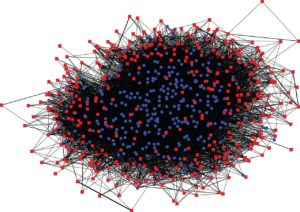 Collating 73,790 observations of 653 humpback whales sighted more than 20 times over a 27 year period allowed us to trace the spread of a hunting innovation first spotted in a single individual. This ‘lob-tail’ behaviour involves smacking the tail on the ocean surface to make a shoal of fish bunch, and be more efficiently harvested by the whales’ ‘bubble-netting’ hunt technique.
Collating 73,790 observations of 653 humpback whales sighted more than 20 times over a 27 year period allowed us to trace the spread of a hunting innovation first spotted in a single individual. This ‘lob-tail’ behaviour involves smacking the tail on the ocean surface to make a shoal of fish bunch, and be more efficiently harvested by the whales’ ‘bubble-netting’ hunt technique.
Mapping the social network of the whales by observing who associated with whom revealed that the new innovation had diffused along the lines of the network, thus implicating social learning [1]. In similar fashion, being a socially central ‘well-connected’ monkey predicted the adoption of alternative foraging methods we introduced experimentally into two groups of monkeys [2].
[1] J.Allen, M. Weinrich, W. Hoppitt, & L. Rendell. ‚Network-based diffusion analysis reveals cultural transmission of lobtail feeding in humpback whales’. Science 340, 485-488.